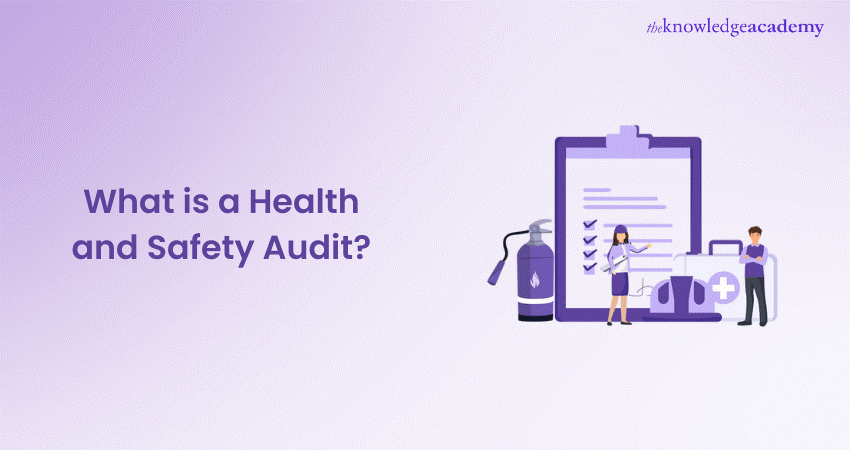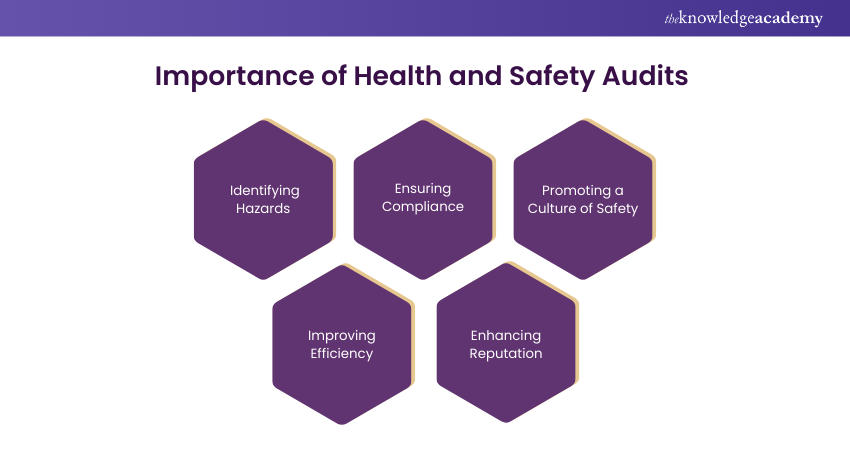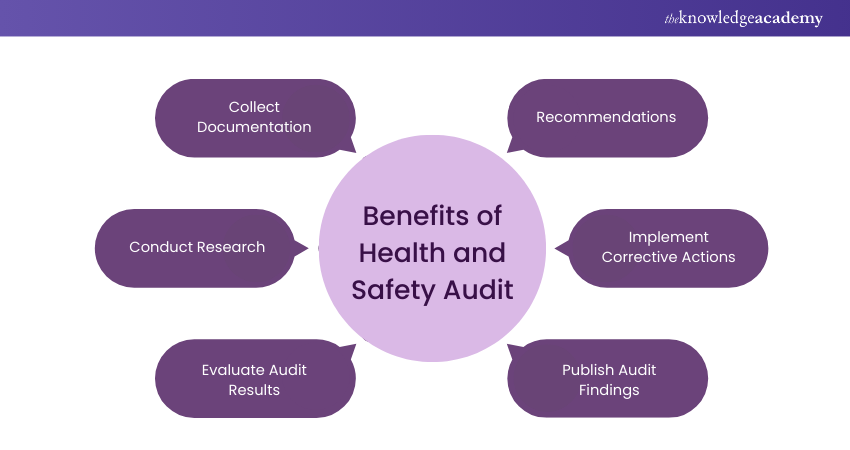We may not have the course you’re looking for. If you enquire or give us a call on + 1-866 272 8822 and speak to our training experts, we may still be able to help with your training requirements.
We ensure quality, budget-alignment, and timely delivery by our expert instructors.

You’ve probably noticed a bustling factory where workers are constantly on the move, machinery hums in the background, and safety is paramount. But, ever wondered how can such an environment ensure it meets all safety standards? This is where a Health and Safety Audit comes into play. It is a systematic examination of workplace safety protocols and practices. This blog will walk you through everything you need to know about conducting this audit.
From understanding the basics to implementing effective audit strategies, this blog will help you ensure your workplace is a safe haven for all employees. Let’s dive in and explore the essentials of a Health and Safety Audit.
Table of Content
1) What is a Health and Safety Audit?
2) Importance of Health and Safety Audits
3) Health and Safety Audit Process
4) Benefits of Health and Safety Audit
5) Frequency of Health and Safety Audits
6) Internal or External Health & Safety Audits: Which one to Choose?
7) Conclusion
What is a Health and Safety Audit?
A Health and Safety Audit is like an intensive check-up for a place of work. It's a manner where specialists observe the whole thing inside the place of business to ensure all individuals are safe. They consider things like regulations, methods, and devices to see if they meet protection requirements.
The intention is to locate any dangers or risks and make improvements to keep everyone safe. Think of it as a way to ensure the place of job is a steady surrounding for everyone working there.
Importance of Health and Safety Audits
Health and Safety Audit is a vital tool that ensures the well-being of everyone in the workplace. Here's why it matters:

1) Identifying Hazards
Health and Safety Audits assist in discovering potential risks and dangers within the workplace environment. Identifying those threats early on can help take critical measures to mitigate dangers and prevent injuries.
2) Ensuring Compliance
Audits ensure that the corporation follows all relevant Health and Safety requirements and regulations. This helps to avoid criminal penalties, fines, and reputational harm from non-compliance.
3) Promoting a Culture of Safety
Regular safety checks remind everyone in the place of how essential protection is in the business. When personnel see that the management regularly checks for safety, they're more likely to make safe alternatives every day. This creates a place of work, where protection isn't always just a rule but something anybody cares approximately.
4) Improving Efficiency
Audits contribute to a more efficient and productive workplace by addressing potential dangers and improving safety protocols. When safety concerns are minimised, employees can focus on their tasks without the distraction of worrying about their well-being.
5) Enhancing Reputation
A dedication to protection via regular Audits complements the agency's reputation amongst employees, clients, and stakeholders. It demonstrates duty and care for the welfare of personnel and may definitely effect the organisation's reputation.
Health and Safety Audits are important in developing a secure, compliant, and productive work environment. It benefits each employees and the company as a whole.
Sign up for our Manual Handling At Work Course and learn the essential techniques to prevent injuries
Health and Safety Audit Process
The Health and Safety Audit process involves several key steps to ensure a thorough examination of Workplace Safety practices. Here's an overview of the steps involved:
1) Planning and preparation
This initial phase involves determining the scope and objectives of the Audit. It includes selecting the Audit team, defining Audit criteria, and establishing a timeline for the Audit process.
2) Documentation Review
The Audit team examines relevant documentation, such as safety policies, procedures, incident reports, and regulatory requirements. This helps identify areas to focus on during the Audit.
3) On-site Inspection
The Audit team runs a physical inspection of the workplace to assess safety conditions firsthand. They observe work practices, inspect equipment and facilities, and identify any potential troubles or non-compliance issues.
4) Interviews and Observations
During the on-site inspection, the Audit team may interview employees to gather information about safety practices and procedures, referring to Health and Safety Interview Questions to ensure a thorough assessment. They also observe work activities to assess adherence to safety protocols.
5) Data Analysis
After gathering information from documentation, interviews, and observations, the Audit team analyses the data to identify trends, patterns, and areas of concern. This analysis helps prioritise findings and determine corrective actions.
Want to have deeper knowledge in the field of health and safety, refer to our blog on What is Nebosh.
6) Findings Report
The Audit team prepares a findings report summarising the results of the Audit. This report typically includes observations, findings, and recommendations for improving safety practices and addressing any non-compliance issues.
7) Corrective Action Plan
Based on the findings report, management develops a corrective action plan to address identified issues and improve safety performance. This plan outlines specific actions, responsibilities, timelines, and resources needed to implement corrective measures.
8) Follow-up and Monitoring
Management monitors the implementation of corrective actions to ensure they effectively address identified issues. Follow-up Audits may be conducted periodically to verify compliance and track progress over time.
Register for our Safeguarding Officer Training and become a key player in protecting vulnerable individuals.
Benefits of Health and Safety Audit
Health and Safety Audits offer numerous advantages for organisations striving to maintain a safe and secure workplace environment. Let's delve into the key benefits.

1) Collect Documentation
Managers and supervisors gather essential documentation related to safety policies, procedures, incident reports, and regulatory requirements. This documentation provides a thorough understanding of the organisation's safety protocols, offering valuable insights into existing practices and areas for improvement.
2) Conduct Research
Audits delve deep into Workplace Safety, carrying out thorough studies to identify potential risks and dangers. This proactive method allows establishments to live in advance of emerging protection worries and deal with them efficiently earlier than they increase into injuries.
3) Evaluate Audit Results
Businesses can evaluate their safety performance objectively through Audits. This report helps management gain valuable insights into the effectiveness of existing safety measures. They will be able to identify both strengths and weaknesses within the Safety Management system.
4) Recommendations
Based on Audit findings, guidelines are made to decorate safety protocols and mitigate risks effectively. These guidelines can also consist of updates to policies and strategies, additional training for personnel, or enhancements to safety device and infrastructure.
5) Implement Corrective Actions
Audits facilitate the implementation of corrective actions to address identified hazards. Organisations demonstrate their commitment to prioritising the well-being of the workforce. They create a safe work environment by taking prompt and decisive action to rectify safety deficiencies.
6) Publish Audit Findings
Transparency is crucial in promoting a safe culture in a company. By publishing Audit findings, management fosters accountability and transparency, encouraging open communication about safety concerns and solutions. This transparency also builds trust among employees, demonstrating that their safety is a top priority for the organisation.
Be a leader and enhance Workplace Safety confidently with our NEBOSH HSE Certificate in Health and Safety Leadership Excellence Training. Join today!
Frequency of Health and Safety Audits
The frequency of Health and Safety Audits can vary depending on several factors. However, organisations conduct Audits regularly to ensure ongoing compliance and effectiveness of safety measures. Typically, organisations may opt for:
1) Annual Audits
Conducting annual Audits allows businesses to assess their safety performance comprehensively and ensure compliance with regulatory requirements. Annual Audits provide a regular opportunity to identify emerging safety concerns and address them proactively.
2) Biannual Audits
Some companies may choose to conduct Audits every six months to maintain a closer eye on safety performance and address any issues that may arise more frequently. Biannual Audits offer a balance between regular monitoring and resource allocation.
3) Quarterly Audits
Quarterly Audits ensure timely identification and mitigation of risks for high-risk industries or workplaces with dynamic safety hazards. These Audits provide more frequent opportunities for monitoring safety performance and implementing corrective actions.
4) Continuous Monitoring
Some organisations implement continuous monitoring systems in addition to periodic Audits to track safety performance in real-time. This could include regular inspections, incident reporting, and employee feedback mechanisms to maintain ongoing awareness of safety issues.
In the end, the frequency of Health and Safety Audits depends on the specific needs and risks of the organisation. Regular Audits, whether conducted annually, biannually, quarterly, or through continuous monitoring, are essential for maintaining a safe and healthy workplace environment. It ensures compliance with safety regulations.
Ensure a safer workplace environment with our comprehensive Helath and Safety Courses.
Internal or External Health & Safety Audits: Which one to Choose?
When deciding to perform a Health and Safety Audit, organisations have two options, that include either hiring an External Auditor or conducting an Internal Audit.
An internal audit can be conducted by a “competent person,” and most companies often form an audit committee to oversee the audit processes. In-house audits are generally more cost-effective and provide greater control over the entire process.
However, for larger organisations, an external audit is the preferable option. External audits are held in accordance with the principles outlined in the Health, Safety, and Environment (HSE) Best Practice Document Health and Safety Guidance (HSG65). Additionally, external auditors can benchmark organisations against competitors, potentially enhancing the company’s overall image.
Conclusion
In conclusion, a Health and Safety Audit is your key to ensuring a compliant workplace. By following this complete blog, you’ll be well-equipped to figure out potential hazards and implement effective safety measures. Regular audits not only enhance safety but also boost employee morale and productivity.
Equip your team with life-saving skills by investing in our First Aid at Work Training – book your spot now!
Frequently Asked Questions
What are the key Stages of Health and Safety Audit?

The crucial stages of a Health and Safety Audit include planning and preparation, data collection through inspections and interviews, reviewing documentation, identifying hazards, assessing compliance with safety regulations, and evaluating current safety procedures.
Can you Produce an Internal Safety Audit?

Yes, we can produce a thorough internal safety audit tailored to your organisation, ensuring compliance with relevant Health and Safety regulations.
What are the Other Resources and Offers Provided by The Knowledge Academy?

The Knowledge Academy takes global learning to new heights, offering over 3,000 online courses across 490+ locations in 190+ countries. This expansive reach ensures accessibility and convenience for learners worldwide.
Alongside our diverse Online Course Catalogue, encompassing 19 major categories, we go the extra mile by providing a plethora of free educational Online Resources like News updates, Blogs, videos, webinars, and interview questions. Tailoring learning experiences further, professionals can maximise value with customisable Course Bundles of TKA.
What is The Knowledge Pass, and How Does it Work?

The Knowledge Academy’s Knowledge Pass, a prepaid voucher, adds another layer of flexibility, allowing course bookings over a 12-month period. Join us on a journey where education knows no bounds.
What are the Related Courses and Blogs Provided by The Knowledge Academy?

The Knowledge Academy offers various Health & Safety in the Workplace Trainings, including the First Aid at Work Training, Manual Handling at Work, and Food Safety Training . These courses cater to different skill levels, providing comprehensive insights into the Importance of Health and Safety.
Our Health & Safety Blogs cover a range of topics related to Workplace Safety, offering valuable resources, best practices, and industry insights. Whether you are a beginner or looking to advance your Workplace Safety skills, The Knowledge Academy's diverse courses and informative blogs have you covered.
Upcoming Health & Safety Resources Batches & Dates
Date
 IOSH Managing Safely Course
IOSH Managing Safely Course
Mon 17th Mar 2025
Mon 26th May 2025
Mon 14th Jul 2025
Mon 22nd Sep 2025
Mon 24th Nov 2025
Mon 8th Dec 2025






 Top Rated Course
Top Rated Course



 If you wish to make any changes to your course, please
If you wish to make any changes to your course, please


